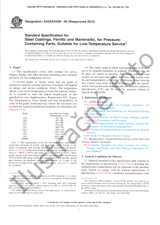Potrebujeme váš súhlas na využitie jednotlivých dát, aby sa vám okrem iného mohli ukazovať informácie týkajúce sa vašich záujmov. Súhlas udelíte kliknutím na tlačidlo „OK“.
ASTM D8308-21
Standard Practice for Cannabis/Hemp Operation Compliance Audits
NORMA vydaná dňa 15.2.2021
Informácie o norme:
Označenie normy: ASTM D8308-21
Dátum vydania normy: 15.2.2021
Kód tovaru: NS-1020827
Počet strán: 14
Približná hmotnosť: 42 g (0.09 libier)
Krajina: Americká technická norma
Kategória: Technické normy ASTM
Kategórie - podobné normy:
Anotácia textu normy ASTM D8308-21 :
Keywords:
cannabis, cannabis assessment, cannabis audit, cannabis best practices, cannabis compliance, cannabis internal audit, hemp, marijuana,, ICS Number Code 65.020.20 (Plant growing)
Doplňujúce informácie
| Significance and Use | ||||||||||||||||||||||||||||
|
4.1?Intended UseThis practice is intended for use by parties who either develop, plan, and conduct internal or external audits, or are interested in the audit process since they are the subject of compliance audits or they mandate such audits to occur. 4.2?AuditsAudits are conducted by an auditor or audit body that is independent of the entity being audited. Individuals that conduct an assessment of an operation or product that they are directly involved with or have a vested interest in, is technically not an audit. These assessments might be a pre-audit or gap assessment. This practice can be used for these types of activities and the rigor of a true audit may not be as critical. 4.3?Terms and ConceptsThe definition of terms in Section 3 and the perspectives on scale, objectives, and types of audits in Annex A3 provide concepts that help clarify the different roles involved in an audit, the various elements of an audit, and how this practice applies to different situations. This practice is written in terms that accommodate audits for different objectives and sizes. 4.4?ApplicationCompliance audits are used to identify gaps between some criteria and the actual operational conditions. Knowledge of gaps are used to assess various risks, guide corrective action, preventive action, root cause analysis, improvement efforts, prevent fines and penalties, or provide stakeholders an objective evaluation of an operation and its potential safety, financial, or other risks. A user of this practice should understand and adapt the audit concepts, process, and responsibilities in this practice to their specific organizational structure and situation. 4.5?Audit ScaleThe scale of an audit can range from an internal audit of a small single operation with fewer than ten employees to an external audit of a large corporation with facilities at multiple international locations. In either case, large or small, the principles in this practice shall be followed to produce objective and credible results. 4.6?Audit CriteriaAs the cannabis/hemp industry develops globally and continues to gain acceptance, both new and previously established standards, regulations, policies, and best practices are being developed, adopted, evolving, and applied to this industry. Due to this evolving nature, diligent attention is needed by auditing bodies to maintain up-to-date audit criteria and protocols. |
||||||||||||||||||||||||||||
| 1. Scope | ||||||||||||||||||||||||||||
|
1.1?PurposeThis practice identifies the minimum requirements for the planning, conduct, and reporting of compliance audits of a cannabis/hemp business. It provides information on terms, procedures, and responsibilities. 1.2?IntentThe intent is to provide specific instruction needed to develop reliable audit programs and procedures that are used to conduct audits that produce credible, consistent, and objective evidence and findings related to compliance with one or more standards, regulations, policies, best practices, or quality specifications. This practice can be used internally for pre-audit assessments to identify and correct operational gaps. 1.3?OrganizationThis practice is organized in the following manner:
1.4?Nothing in this practice shall preclude observance of federal, state, or local regulations which may be more restrictive or have different requirements. 1.5?This standard does not purport to address all of the safety concerns, if any, associated with its use. It is the responsibility of the user of this standard to establish appropriate safety, health, and environmental practices and determine the applicability of regulatory limitations prior to use. 1.6?This international standard was developed in accordance with internationally recognized principles on standardization established in the Decision on Principles for the Development of International Standards, Guides and Recommendations issued by the World Trade Organization Technical Barriers to Trade (TBT) Committee. |
||||||||||||||||||||||||||||
Odporúčame:
Aktualizácia technických noriem
Chcete mať istotu, že používate len platné technické normy?
Ponúkame Vám riešenie, ktoré Vám zaistí mesačný prehľad o aktuálnosti noriem, ktoré používate.
Chcete vedieť viac informácií ? Pozrite sa na túto stránku.




 Cookies
Cookies
